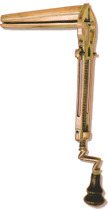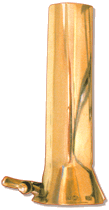


Vaginal speculum
|
(Left) Trivalvar Vaginal Speculum: Wood and steel; 18th century; 12x28x9,2cm (Right) Trivalvar Vaginal Speculum: Silver; 1843-61; 9x16x6,5cm |
The present trivalve speculum has little difference in shape when compared with those found in Pompeii and Herculaneum (97 D.C.). The difference lies on the materials used in the production: wood and steel instead of bronze. This is an expected composition in a period prior to the introduction of antisepsis/asepsis.
In the Portuguese surgical bibliography you can read about the existence of vaginal and uterine specula, although the information about their shape and materials is scarce, which does not happen with the other types of specula.
The silver speculum that we have chosen has three marks in it. In one of them initials can be seen, that are the trademark of one unidentified goldsmith from Porto, with the contrasts P-36 and P-37 (ALMEIDA Fernando Moitinho - Inventário de Marcas de Pratas portuguesas e brasileiras. Lisboa: Imprensa Nacional - Casa da Moeda, 1993) of the assayer Luís António Rodrigues de Araújo, between 1843 and 1853. The eleven coins mark (0,917) is imputed to the same assayer (connected to P-37) who used it between 1843 and 1861.
This is an example that emphasizes the importance of investigating marks on surgical instruments to achieve a precise manufacture dating. The preference for silver in the production of this instrument can be explained by its greater resistance to corrosion by the organic fluids and, maybe, by the refined taste of its owner.

